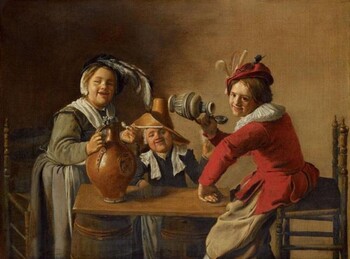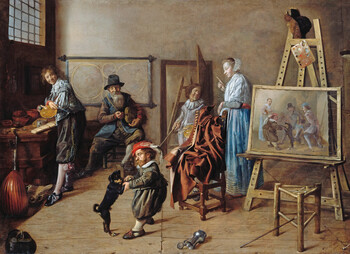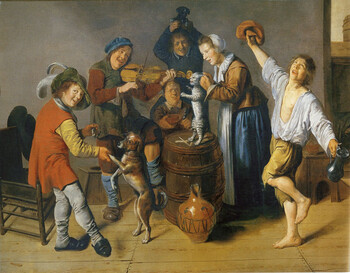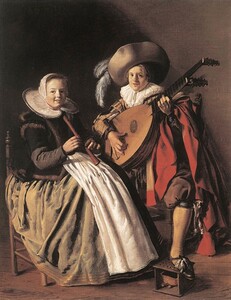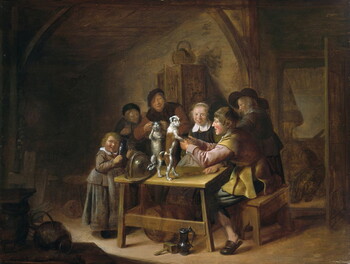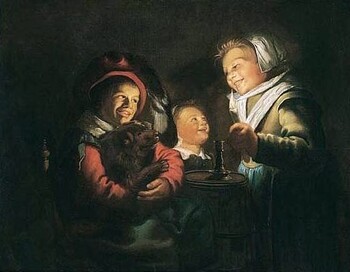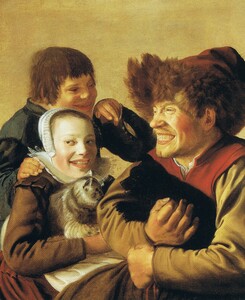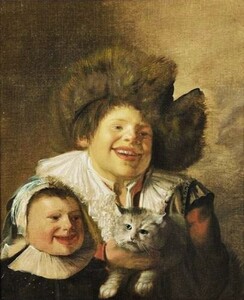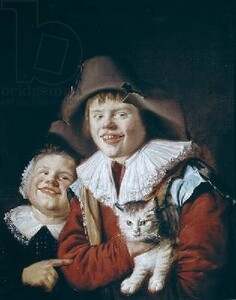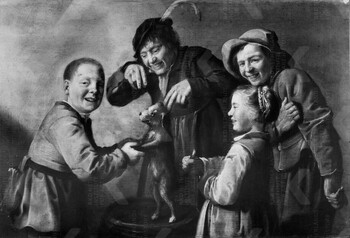11.000 €
Interior scene with children making music
Oil on panel : 54,1 X 65,3 cm
Unsigned
Frame : 73,5 X 85,8 cm
Provenance : sold at Sotheby’s Amsterdam, 13/05/03 for 10.980 € as “studio of Jan Miense Molenaer”. That attribution had been endorsed by Dennis P. Weller, who dated the painting circa 1628.
Our painting is recorded at the RKD, The Hague as “attributed to Jan Miense Molenaer” under the number 0000135318. The RKD states that the painting must be slightly younger, dating from the 1630s.
In short
Jan Miense Molenaer was an excellent painter of the ordinary behaviour of the lower social classes. His scenes must have been a source of laughter for his clients in Haarlem and in Amsterdam. Molenaer had been a pupil of Frans Hals in Haarlem. He married one of the most famous female painters of the seventeenth century, Judith Leyster. But while his art is funny and vivid, he himself had an absolutely pugnacious character.
About Jan Miense Molenaer
Dutch painter
Haarlem 1609/10 – 1668 Haarlem
Jan Miense Molenaer specialised in genre scenes, but his oeuvre also extends into portraiture, history painting and scenes of contemporary theatre.
He was a pupil of Frans Hals, possibly also of his younger brother Dirk Hals.
He was active in Haarlem and in nearby Heemstede (1629-1636, 1648-1655, 1657-1668) and in Amsterdam (1637-1648, 1655-1656).
Molenaer seems to have had a pugnacious and generally unpleasant character: disputes over relatively insignificant matters and amounts became a second occupation. When he was not suing others for non- payments, his own property was being confiscated. Although he was constantly fighting over finances with his creditors the inventory of his possessions made after his death suggests he was rich.
In 1636 he married Judith Leyster (1609-1660), one of the most famous female painters of the 17th century. She sacrificed her successful career for family life. The couple had five children.
There is a marked difference between Molenaer’s early and late pictures, both in subject matter and in style.
The early works, dating between 1629 and 1640, are considered to belong to his best creative period, when he produced colourful paintings full of inventive symbolism, wit and humour, influenced by Frans Hals.
After 1640 Molenaer turned to tonal colours, mostly depicting the behaviour of peasants, the ordinary life of the underclass. This change followed his move from Haarlem, where his financial situation had been desperate, to the booming metropolis of Amsterdam in 1637. In the highly specialised art market of those days Molenaer tried to become the low-life specialist of Amsterdam, aiming to get a position comparable to that of Adriaen and Isaac van Ostade in his native Haarlem. Such a genre scenes with happy merrymakers were both a source of delight and of instruction for the town population of the young, Protestant Dutch Republic.
Molenaer’s move in 1648 from Amsterdam to a heavily mortgaged house in the village of Heemstede, south of Haarlem, divides this second period of creation in two. While his Amsterdam years had been years of hope, of a new direction in his artistic development, the paintings from his later career, after 1649, hold fewer originality and contain often recycled popular motifs of interior scenes. Still in these last two decades of his life his production was unexpectedly large and the quality remained high.
Molenaer should be seen as an active participant in the Brueghel revival that occurred in the second quarter of the 17th century. He continued the Haarlem tradition of peasant scenes founded by Adriaen Brouwer and Adriaen van Ostade, leading to his younger contemporary Jan Steen.
About our painting
Jan Miense Molenaer regularly painted people playing with cats and dogs, both adults and children.
Our composition stands close to an unsigned painting sold at auction in Zurich in 1984. It also holds our four main figures. That painting is attributed in full to Molenaer. Both paintings date from the 1630s, either from the last years that Jan Miense was still living in Haarlem or maybe from his early years in Amsterdam.
Why should you buy this painting?
Because it testifies of the genius of Jan Miense Molenaer at a very young age.
Comparative paintings
Click photos for more details


